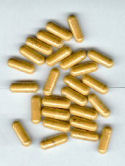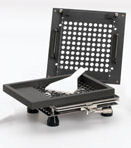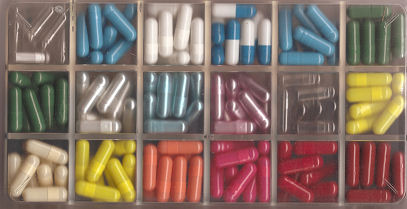Red Korean ginseng - Capsules
Capsules
One of the key activities of Benseng International BV is filling hard-gel capsules with Ginseng. Fillers, additives or other medicinal herbs or food supplements may be added to the capsules too.A hard-gel capsule is usually filled with powders or granulates. Two halves of the capsule are clicked together to close it.
 |
Red Korean Ginseng hard-gel capsules can be filled with ground Ginseng root powder or with Ginseng extract powder |
Contents
Capsules can contain ground Root Powder as well as Ginseng Extract powder, with or without additives.Root powder: The dried Ginseng roots are ground to a fine powder, with a standardized level of ginsenosides that varies between 3% and 7%. The most commonly used root powder in capsules contains 6% ginsenosides. For an optimal efficacy of this powder, a daily intake of 1-2 capsules is sufficient. An advantage of root powder is, that it still contains all substances naturally found in the root.
Extract powder: In a carefully controlled process all active ingredients are extracted from the Ginseng root and dried in to a powder. White Korean Ginseng extract powders contain 8% to 30% of ginsenosides. For capsules, most commonly used is an extract powder containing 8% ginsenosides. For the product to work optimally 1 capsule a day is sufficient. The advantage of extract powder is, that it is absorbed by the body very efficient, promoting quick effects.
Additives: To reduce costs, among other things, adding a filler is a consideration. The most inexpensive additive is rice flour, but for technical reasons and because of taste other additives can be added, for example: dicalcium phosphate, malto-dextrin, magnesium stearate, silicon dioxide or glucose powder. Of course there are other conceivable options.
When deciding to use an additive, it is advised to combine it with an extract powder with the highest possible ginsenoside level. This will ensure an active extract powder en is relatively the cheapest option. Depending on the amount of filler added, the desired ginsenoside level can be obtained.
Another benefit of adding a filler to the extract powder is that it will drastically decrease the hygroscopic nature of the product.
 |
Powders or mixtures that are difficult to process and small batches can be handled. In that case a small hand-driven machine is better suitable than a semi-automatic or full-automatic one. |
Types of capsules
Most common are hard-gel capsules made of animal origin. Increasingly popular however are the ones of vegetable origin: vegetarian capsules.Standard hard gelatin capsule: made of collagen: a fibrous protein composed of 18 different amino-acids found in the tissue and bones of animals. The natural collagen from animals is macerated and purified after which it is processed into capsules.
Vegetable hard gelatin capsule: made of cellulose-like raw material named HPMC (Hydroxy Propyl Methyl Cellulose). These VEGI-caps or Vcaps meet the strict dietary needs of people with a vegetarian lifestyle. In addition these capsules do not contain starch, gluten or preservatives.
Size of capsules
For red Korean Ginseng capsules the most commonly used size is a so-called size "0" capsule. Occasionally a larger "00" or a smaller "1" is used. |
All sizes of hard-gel capsules are also available in the so-called "EL=Extra Long" variety (approximately 10% longer and more capacity). For most of these special capsules a certain minimal purchase quantity is applicable.
 |
Hard gelatin capsules are available in many possible colors and sizes. |
Color
Red Korean Ginseng capsules are mostly transparent of color. White and ivory are additional popular choices. The hardgel capsules are available in almost any possible color or color combination.Filling weight capsules
On average the smallest possible capsule is preferred by consumers: it is easier to swallow. Suppliers usually prefer a large capsule because it is relatively cheaper.The powder capacity for a certain capsule depends on the volume weight of the powder and in lesser extent how it is filled (automatically or by hand).
 |
Packaging
Normally Red Korean Ginseng capsules are offered in bulk packaging, but delivery in any desired packaging is possible: separated in a bottle/jar of blistered in a box.Double weight- and amount controls guarantee that you receive what you ask for.
Dosage
In-vitro-tests have shown that the absorption of ginsenosides from extracts is double the absorption of dried ginseng roots or root powders. Counted in milligrams, this means that in order to get the same results a double dose of ground root powders is needed in comparison to extract powders.For Red Korean ginseng extract powders an advised optimal therapeutic dose is 15-30 mg of pure ginsenosides daily. For capsules with 400 mg of ginseng extract powder that contain for example 8% ginsenosides, then 1 capsule a day should be sufficient.
When taking capsules with Red Korean ginseng root powder, an optimal therapeutic dose would be 30-60 mg pure ginsenosides daily. For ginseng capsules with 450 mg of Red Korean ginseng root powder that contain 6% ginsenosides, that would be 1 to 2 capsules daily.
Practical experiences have demonstrated that activity and effects of Red Korean Ginseng do not decline proportionally as a daily dose is lowered.
There is no dangerous (damaging) maximum daily dose, but 7 mg ginsenosides is considered as a minimal dose. If you take less than 7 mg a day it will most likely not contribute anything.
When mixed with other medicinal herbs, a lower dose of Red Korean Ginseng might be sufficient.
 |
 |
| previous | next |
